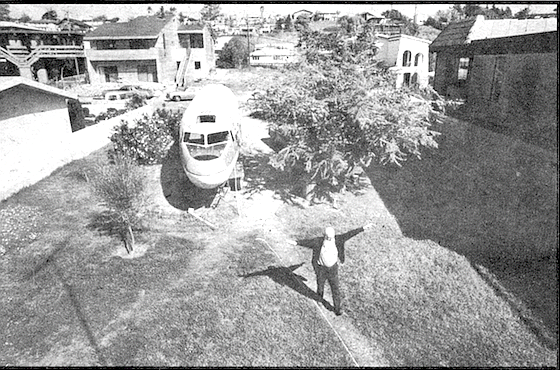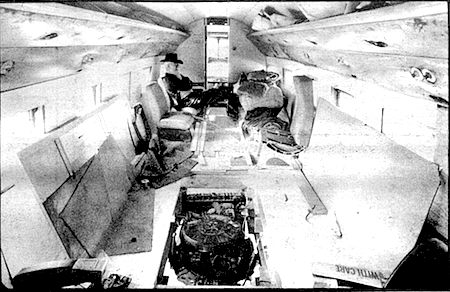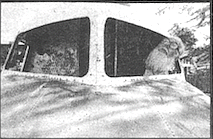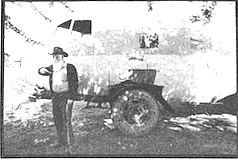 Facebook
Facebook
 X
X
 Instagram
Instagram
 TikTok
TikTok
 Youtube
Youtube

The freeways are crawling with animals. Colts, Stingrays and even Cougars abound. Pintos vie with Mustangs; Skylarks make way for Thunderbirds; and Rabbits hop from cloverleaf to underpass. Even the insect world is represented; German Beetles infest our roadways.
Mass-produced, all the above vehicles are rather common — indigenous, if you will, to the highways and byways of America. Usually they attract little more than a casual glance in the rearview mirror. One takes them for granted and accelerates into the next lane.

But once in a while something unique and truly beautiful comes down the pike. For the most part, such phenomena are the result of a long and loving restoration project. One may appreciate the splendor of a shiny Model-T, or the classic lines of a 1926 Bentley. Rarely, however, does anything so strange and remarkable as the “Goony Bird” appear. Though it has yet to take its maiden voyage, when it does hit the road it is sure to cause many a rubber-neck, numerous ohs and ahs, and perhaps a few outright yelps.
The Goony Bird is the brainchild of H. L. (Smokey) Rolland, the quintessential jack-of-all-trades. His employment history spans half a century and includes everything from barnstorming to acting to logging.
In his grease-smeared work clothes and navy blue watchcap, Rolland looks like any weekend mechanic, that breed of man so often found in basement or garage — breathing ritual curses upon stubborn nuts and bolts. Behind his full white beard and weathered face, however, a spark of true artistry lurks. Possessed of an engineering background, Rolland employs that field’s impressive technical jargon —- exhaust manifold pressures, torque stats, and gear ratios roll off his fuel injected . tongue with ease. In one tool-scarred hand a cigarette invariably bums. The other supports a glass of sour mash whiskey, the dilution of which — to Rolland’s mind — is an act of sacrilege.
About eighteen months ago the stocky resident of Cardiff decided he wanted something different. He was tired of painting flagpoles and radio towers and yearned for a less windy project, one that would keep him on the ground. Out of such thinking was the Goony Bird conceived. Now in gestation, it may be the most unlikely collection of parts ever assembled for the road.
The DC-3 in Rolland’s front yard is thirty-nine feet long. Wingless, and mounted on the chassis of an old school bus, it stands ten to twelve feet high. From black nose to truncated stern, the Goony Bird is an imposing aerodynamic sight, an enormous bullet on wheels. The project has cost Smokey Rolland considerable amounts of time and money from the start.

“I spent $300 on the telephone,” he explained, “just locating the fuselage. Before I found it I made a trip to Denver and one to San Francisco — both for nothing."
But Rolland is not the type of man to be discouraged. After six months his scavenger hunt came to an end in Tucson, Arizona. There, he paid $1500 for the GMC bus chassis and another $9000 for the mothballed DC-3. He had the wings and four feet of the tail section removed, sold them to a man from Texas, and hauled the rest across the desert to San Diego. Once home, Rolland mounted the airplane to the bus chassis — a formidable task — and began the arduous task of readying the Goony Bird for the road. In the course of the past year, various mechanical complications and State DMV requirements have cost him every spare penny he has. There is still much to be done. Nevertheless, Rolland has grand plans for both the interior and exterior of his creation.
“On the nose,” he says, “I want to paint some of them ‘tiger’s teeth,’ like they used to have on those ‘Flying Tigers’ (fighter planes) back in WWII. Man, it’s gonna be good for them alcoholics on the road. They’re gonna take one look at this thing and quit drinkin’ right then and there.”

The interior of the Goony Bird bears the unmistakable appearance of a work-in-progress. At this point, in fact, it is little more than an empty shell. In the rear, decking has been removed for access to certain mechanical innards; after climbing a small step ladder to the door, one must tiptoe across exposed struts to more solid ground. There, a massive engine (480 cubic inches) can be seen through a trap door cut out of the floor. The 300 horsepower motor, salvaged from a Lincoln Continental, occupies a prominent space beneath the center of the fuselage. Secured to the chassis by large wood beams, it is hooked up to an automatic airplane transmission and a “high-speed diesel rear end.”
The scenery is chaotic: a roll of insulation, chunks of plywood, two-by-fours, and countless tools are scattered about inside. A few old chairs and some derelict airplane couches are propped against the bulkheads. The cockpit, stripped of instruments and controls, looks skeletal and forlorn. But when all is done, Rolland promises the roomy fuselage will feature a bedroom, a dining area, and a small kitchen. He also plans to install two bunks, a toilet, a refrigerator and a stove. And that’s not all.
“I’m gonna put my Hammond organ in here,” he says proudly. “I can’t play the s.o.b. with but two fingers, but I’m gonna put ’er in here anyway.”
The Goony Bird was never meant to serve only as a recreational vehicle; Rolland does not intend to suffer a loss on all that he has invested.
“This is the greatest advertising gimmick since the invention of blondes, ” he states repeatedly, “and once I get it on the road I’ll have it made.”
But its creator needs another $1500 to put the Bird in working order, and to date, his search for an enthusiastic investor has proved futile. Despite this unfortunate lack of funds and appreciation, one is given the distinct impression that — one way or another — the homemade craft will roll.
It may take King Kong to drive the vehicle, but Smokey Rolland is sure he can handle it; and he is positive that when he turns the key, the old Lincoln engine will start. Beyond that, he expects the whole assembly — airplane transmission and all — to function smoothly.
“I’ll have plenty of power,” he says with a tobacco-stained grin. “I figure at fifty-five mph that engine won’t even get warm. If you wanted to flatten out on it, and hang in there with it, I imagine she’ll do a hundred on level ground....”
Rolland pauses to hoist a bottle of Kentucky sour mash.
“...But I ain’t gonna be runnin’ this damn thing at a hundred miles an hour... noooo way brother, not me. I’m just a card-carrying coward.”


The freeways are crawling with animals. Colts, Stingrays and even Cougars abound. Pintos vie with Mustangs; Skylarks make way for Thunderbirds; and Rabbits hop from cloverleaf to underpass. Even the insect world is represented; German Beetles infest our roadways.
Mass-produced, all the above vehicles are rather common — indigenous, if you will, to the highways and byways of America. Usually they attract little more than a casual glance in the rearview mirror. One takes them for granted and accelerates into the next lane.

But once in a while something unique and truly beautiful comes down the pike. For the most part, such phenomena are the result of a long and loving restoration project. One may appreciate the splendor of a shiny Model-T, or the classic lines of a 1926 Bentley. Rarely, however, does anything so strange and remarkable as the “Goony Bird” appear. Though it has yet to take its maiden voyage, when it does hit the road it is sure to cause many a rubber-neck, numerous ohs and ahs, and perhaps a few outright yelps.
The Goony Bird is the brainchild of H. L. (Smokey) Rolland, the quintessential jack-of-all-trades. His employment history spans half a century and includes everything from barnstorming to acting to logging.
In his grease-smeared work clothes and navy blue watchcap, Rolland looks like any weekend mechanic, that breed of man so often found in basement or garage — breathing ritual curses upon stubborn nuts and bolts. Behind his full white beard and weathered face, however, a spark of true artistry lurks. Possessed of an engineering background, Rolland employs that field’s impressive technical jargon —- exhaust manifold pressures, torque stats, and gear ratios roll off his fuel injected . tongue with ease. In one tool-scarred hand a cigarette invariably bums. The other supports a glass of sour mash whiskey, the dilution of which — to Rolland’s mind — is an act of sacrilege.
About eighteen months ago the stocky resident of Cardiff decided he wanted something different. He was tired of painting flagpoles and radio towers and yearned for a less windy project, one that would keep him on the ground. Out of such thinking was the Goony Bird conceived. Now in gestation, it may be the most unlikely collection of parts ever assembled for the road.
The DC-3 in Rolland’s front yard is thirty-nine feet long. Wingless, and mounted on the chassis of an old school bus, it stands ten to twelve feet high. From black nose to truncated stern, the Goony Bird is an imposing aerodynamic sight, an enormous bullet on wheels. The project has cost Smokey Rolland considerable amounts of time and money from the start.

“I spent $300 on the telephone,” he explained, “just locating the fuselage. Before I found it I made a trip to Denver and one to San Francisco — both for nothing."
But Rolland is not the type of man to be discouraged. After six months his scavenger hunt came to an end in Tucson, Arizona. There, he paid $1500 for the GMC bus chassis and another $9000 for the mothballed DC-3. He had the wings and four feet of the tail section removed, sold them to a man from Texas, and hauled the rest across the desert to San Diego. Once home, Rolland mounted the airplane to the bus chassis — a formidable task — and began the arduous task of readying the Goony Bird for the road. In the course of the past year, various mechanical complications and State DMV requirements have cost him every spare penny he has. There is still much to be done. Nevertheless, Rolland has grand plans for both the interior and exterior of his creation.
“On the nose,” he says, “I want to paint some of them ‘tiger’s teeth,’ like they used to have on those ‘Flying Tigers’ (fighter planes) back in WWII. Man, it’s gonna be good for them alcoholics on the road. They’re gonna take one look at this thing and quit drinkin’ right then and there.”

The interior of the Goony Bird bears the unmistakable appearance of a work-in-progress. At this point, in fact, it is little more than an empty shell. In the rear, decking has been removed for access to certain mechanical innards; after climbing a small step ladder to the door, one must tiptoe across exposed struts to more solid ground. There, a massive engine (480 cubic inches) can be seen through a trap door cut out of the floor. The 300 horsepower motor, salvaged from a Lincoln Continental, occupies a prominent space beneath the center of the fuselage. Secured to the chassis by large wood beams, it is hooked up to an automatic airplane transmission and a “high-speed diesel rear end.”
The scenery is chaotic: a roll of insulation, chunks of plywood, two-by-fours, and countless tools are scattered about inside. A few old chairs and some derelict airplane couches are propped against the bulkheads. The cockpit, stripped of instruments and controls, looks skeletal and forlorn. But when all is done, Rolland promises the roomy fuselage will feature a bedroom, a dining area, and a small kitchen. He also plans to install two bunks, a toilet, a refrigerator and a stove. And that’s not all.
“I’m gonna put my Hammond organ in here,” he says proudly. “I can’t play the s.o.b. with but two fingers, but I’m gonna put ’er in here anyway.”
The Goony Bird was never meant to serve only as a recreational vehicle; Rolland does not intend to suffer a loss on all that he has invested.
“This is the greatest advertising gimmick since the invention of blondes, ” he states repeatedly, “and once I get it on the road I’ll have it made.”
But its creator needs another $1500 to put the Bird in working order, and to date, his search for an enthusiastic investor has proved futile. Despite this unfortunate lack of funds and appreciation, one is given the distinct impression that — one way or another — the homemade craft will roll.
It may take King Kong to drive the vehicle, but Smokey Rolland is sure he can handle it; and he is positive that when he turns the key, the old Lincoln engine will start. Beyond that, he expects the whole assembly — airplane transmission and all — to function smoothly.
“I’ll have plenty of power,” he says with a tobacco-stained grin. “I figure at fifty-five mph that engine won’t even get warm. If you wanted to flatten out on it, and hang in there with it, I imagine she’ll do a hundred on level ground....”
Rolland pauses to hoist a bottle of Kentucky sour mash.
“...But I ain’t gonna be runnin’ this damn thing at a hundred miles an hour... noooo way brother, not me. I’m just a card-carrying coward.”
Comments